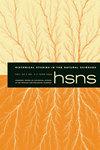猪基因组学的拼贴
IF 0.3
3区 哲学
Q2 HISTORY & PHILOSOPHY OF SCIENCE
引用次数: 1
摘要
猪基因组研究的历史——通过档案研究、口述历史、定量数据集分析和合作作者网络——证明了两种不同谱系的重要性。这包括以农业遗传学为重点的研究项目,以及与进化和多样性有关的系统学研究。从2006年到2011年,这两种研究模式的相对权重随着该物种参考基因组的产生而发生了变化。在这个拐点之前,我们的网络研究主要涉及密集测序,主要集中在提高特定区域和更广泛的基因组数据的分辨率。测序实践后来变得更加广泛,更加注重种群间和种群间序列数据的生成和比较。我们将这些研究模式的转变解释为基因组工具和资源(包括数据和材料)的可用性、流通、分布和交换的功能,这些工具和资源与猪一般有关,并且越来越多地用于特定种群。因此,我们将猪基因组学的历史描述为一种拼凑,遗传学家为了追求他们的研究目标,将他们可以获得的资源(通常是他们为其他目的生产的资源)拼凑在一起。拼凑的概念增加了我们在整个特刊中所展示的基因组学的更厚的视野,并进一步强调了在大规模基因组中心集中于人类参考序列生产的主导的、单薄的叙述的奇点。这篇文章是由Michael García-Sancho和James Lowe编辑的题为“序列和测序者:研究酵母、人类和猪基因组学出现的新方法”的特刊的一部分。本文章由计算机程序翻译,如有差异,请以英文原文为准。
The Bricolage of Pig Genomics
The history of genomic research on the pig (Sus scrofa)—as uncovered through archival research, oral histories, and the analysis of a quantitative dataset and co-authorship network—demonstrates the importance of two distinct genealogies. These consist of research programs focused on agriculturally oriented genetics, on the one hand, and systematics research concerned with evolution and diversity, on the other. The relative weight of these two modes of research shifted following the production of a reference genome for the species from 2006 to 2011. Before this inflection point, the research captured in our networks mainly involved intensive sequencing that concentrated primarily on increasing the resolution of genomic data both in particular regions and more widely across the genome. Sequencing practices later became more extensive, with greater focus on the generation and comparison of sequence data across and between populations. We explain these shifts in research modes as a function of the availability, circulation, distribution, and exchange of genomic tools and resources—including data and materials—concerning the pig in general, and increasingly for particular populations. Consequently, we describe the history of pig genomics as constituting a kind of bricolage, in which geneticists cobbled together resources to which they had access—often ones produced by them for other purposes—in pursuit of their research aims. The concept of bricolage adds to the thicker vision of genomics that we have shown throughout the special issue and further highlights the singularity of the dominant, thin narrative focused on the production of the human reference sequence at large-scale genome centers. This essay is part of a special issue entitled The Sequences and the Sequencers: A New Approach to Investigating the Emergence of Yeast, Human, and Pig Genomics, edited by Michael García-Sancho and James Lowe.
求助全文
通过发布文献求助,成功后即可免费获取论文全文。
去求助
来源期刊

Historical Studies in the Natural Sciences
社会科学-科学史与科学哲学
CiteScore
1.00
自引率
0.00%
发文量
24
审稿时长
>12 weeks
期刊介绍:
Explore the fascinating world of Historical Studies in the Natural Sciences, a journal that reveals the history of science as it has developed since the 18th century. HSNS offers in-depth articles on a wide range of scientific fields, their social and cultural histories and supporting institutions, including astronomy, geology, physics, genetics, natural history, chemistry, meteorology, and molecular biology. Widely regarded as a leading journal in the historiography of science and technology, HSNS increased its publication to five times per year in 2012 to expand its roster of pioneering articles and notable reviews by the most influential writers in the field.
 求助内容:
求助内容: 应助结果提醒方式:
应助结果提醒方式:


